November Devlog: Celebrating Invisible Progress
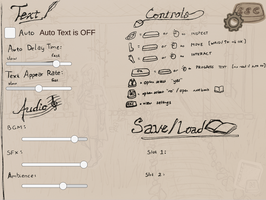
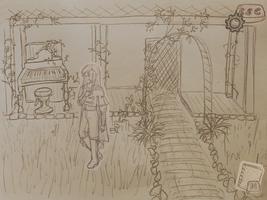

This month I've... accomplished a lot. It's difficult to communicate just how much, because a lot of the work is the kind that isn't exciting to talk about and doesn't look like much... but it is a lot, and it needed to get done. The narrative work I did this month in particular has helped me prepare to finish the full 5-episode saga, not just a new demo or the first episode.
Speaking of the new demo. I originally planned to release it by the end of this year, but it's looking like that was optimistic, considering how much I'm adding from the original demo. New goal is to have it ready for private playtesting by the end of this year, and released publicly early in 2024. Next month I'll confirm if we're still on track for that!
If you'd like sooner updates, or are interested in playtesting, you are welcome to join the Discord server.
Other resources here, including the new website. Now to the devlog!
Highlights for this month:
- Updated Mechanics Implemented: I have built a test scene to triage the new mechanics I've built, and functionality is now at the point where I can start rebuilding the demo with them. I am working with playtesters to identify and iron out bugs as I do so.
- Finalized Narrative + Art Direction: I have determined which art assets will be inked, and which will remain in pencil. Part of this decision involved making a lot of overarching narrative and thematic details concrete, so while I don't have much to show for it at the moment, it will really pay off when the later episodes release.
- Project Management: I now have a part-time job (unrelated to games), and have spent this past month re-learning how to manage my time and keep on track while also getting enough rest. Brief discussion of navigating this adjustment as a solo dev.
- Marketing: This month, I really started thinking more about the kind of marketing *I* appreciate as an audience. I've shared social media posts from other indie dev projects - what is it about those posts that communicated to me I would like the games?
- Recreation: media I engaged with this month!
Updated Mechanics Implemented
I've made improvements, changes, and additions to several core mechanics so that they are flexible enough for me to build a complete game. This has been very complicated because most of the code I wrote for the old demo was very, very limited, and was held together with duct tape that could just barely handle what I built for the demo, and nothing beyond that. So my mission has been to purge the spaghetti and make my scripts able to actually do what I need them to for a more complete game.
It's very easy to get lost on where to start when approaching something like that, so I want to share an approach that really helped me: writing out the intended functionality in just English as comments first, and THEN figuring out how to script it. It's a way of "sketching" code to break down how it will work before getting into the weeds of proper syntax and functionality.

Some specifics on overhauled mechanics:
- Movement - movement scripts can now handle things like an obstacle in the middle of the "walkable" area of the screen. There is polish to do but the core functionality is there and easier to iterate on. I've also added some tweaks that make it "smarter" about handling whether you're currently using point-and-click or WASD inputs.
- Screen Transitions - this mechanic is MUCH more generalized now. It can handle as many entry/exit points from a screen as needed, so scene layouts can be much more varied. A downtown screen with multiple alleys each leading to different screens is possible now.
- Point-and-Click - I made a lot of changes to the point-and-click movement scheme, many of which involved learning how coroutines work; unfortunately, it's still pretty buggy and rough-feeling. I think I made a mistake by trying to make my control scheme support two completely different types of inputs, because it has resulted in two half-polished movement schemes instead of one relatively polished one. However... I cannot bring myself to axe the point-and-click movement scheme, despite WASD currently being more reliable. So I'm going to move forward with the hybrid, and workshop it as I rebuild the demo. The good news is it is at the point where I can safely implement it without breaking anything (hopefully) while I continue to iterate on it. The better news is, even if it's unpolished, I think it makes the game feel very unique.
- Menus - I figured out how to track "layering" the two menus (backlog, and settings screen) so it properly handles freezing/unfreezing movement if you open one on top of the other, and I made the placeholder menus/UI nicer looking. Also added audio volume controls.
The work-in-progress settings menu I currently have is pictured below:
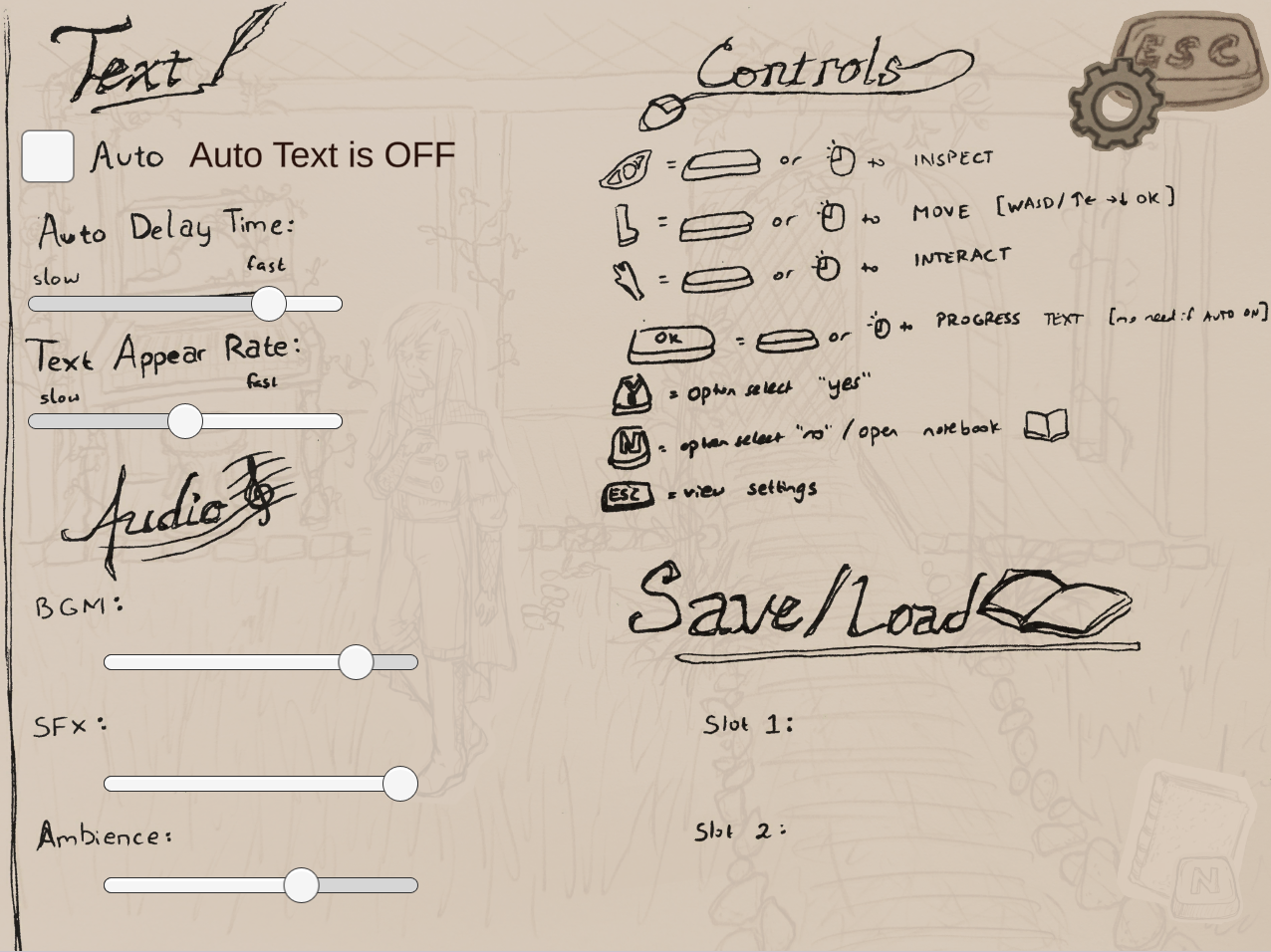
Virtually everything in this image is just a placeholder, but it's a placeholder that feels much better than what I had before. Sketching this out on paper gave me a template to start building on.
I will be utilizing the "notebook" as a shortcut to view the text backlog, as well:
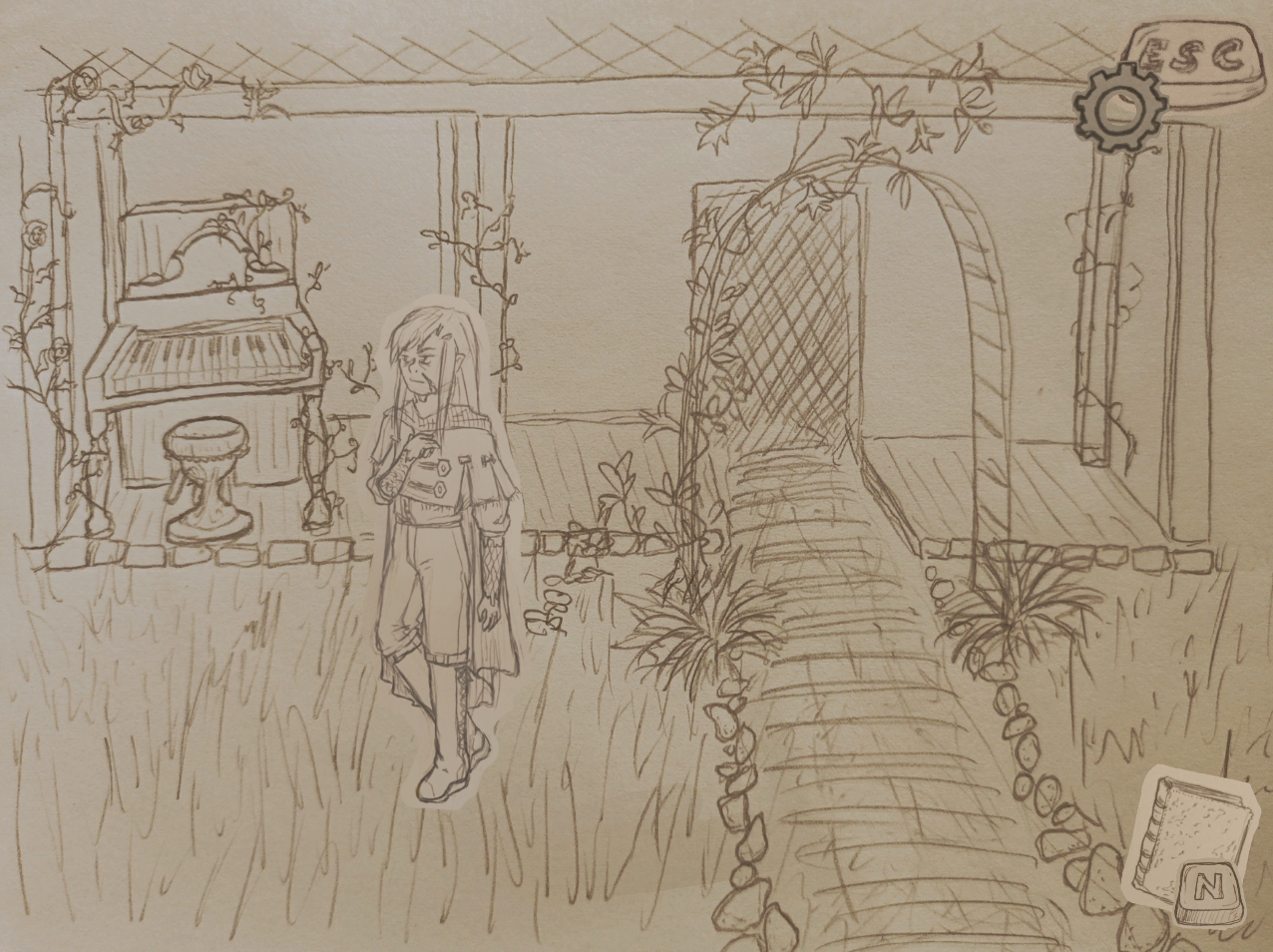
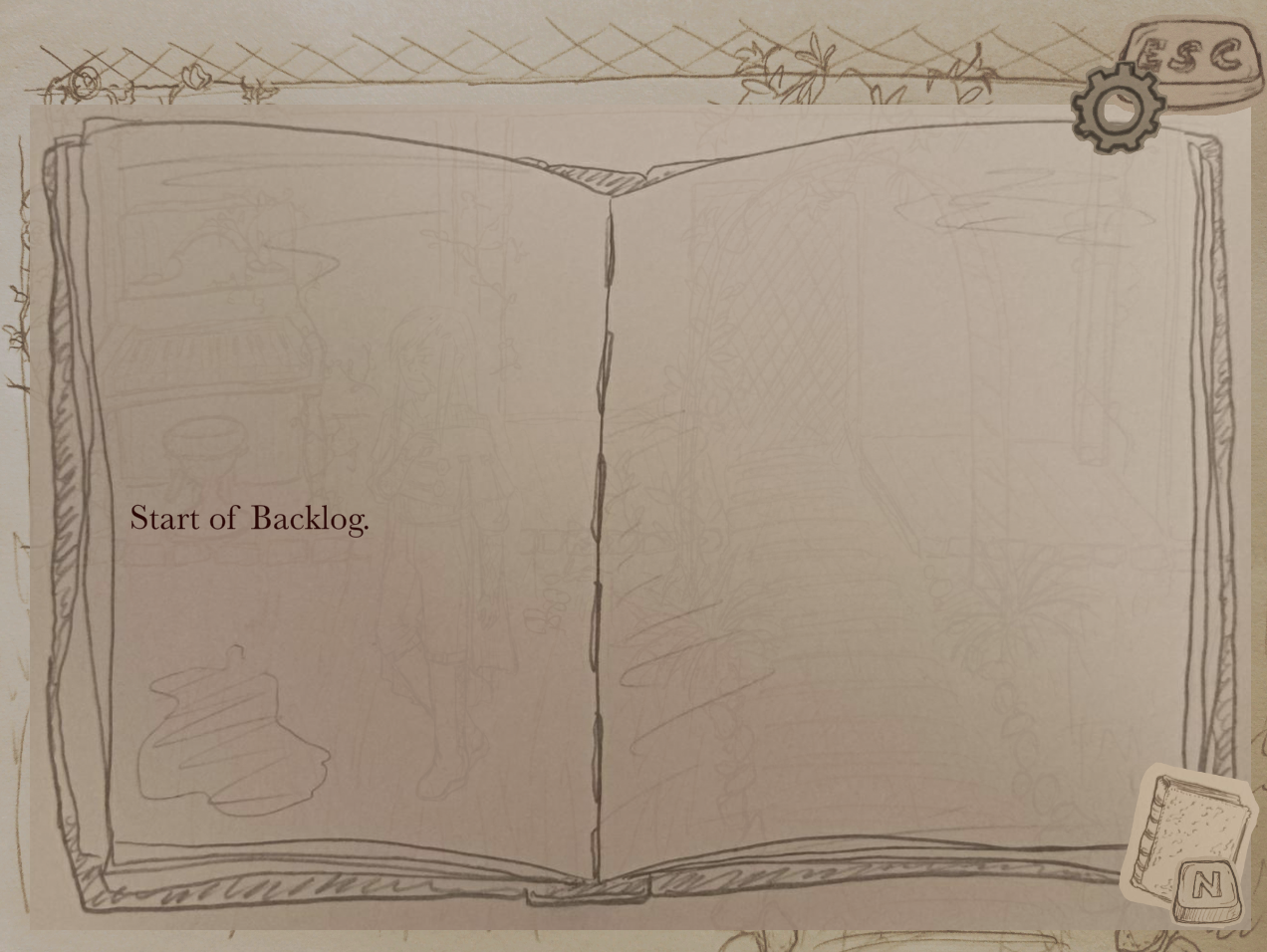
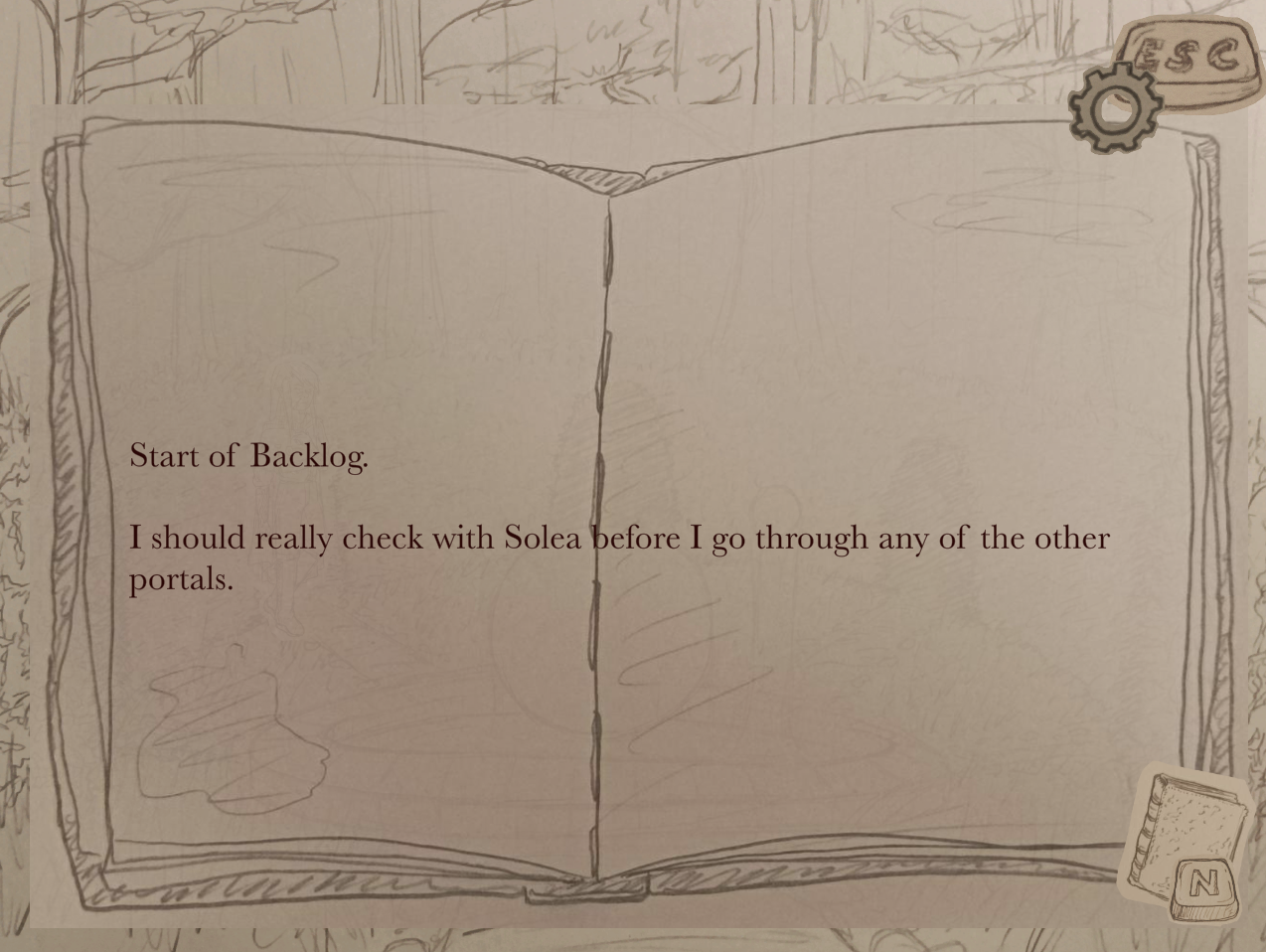
I have more work to do formatting the backlog, but it works, and a scroll-bar is automatically added once it exceeds the height of the backlog window.
Thanks to building this test scene, I've got all of my test scripts to a place where I feel confident rebuilding the demo with the new mechanics. There's a lot that needs to be tweaked and changed, but it's finally at the point where it feels like replacing the existing demo with the new mechanics is pretty much a clear upgrade. So I'm excited to get started on that!
Finalized Narrative + Art Direction
In October's devlog, I wrote that determining precisely which assets will be inked and which will remain in pencil was probably this month's most important project. I debated going with a practical approach (such as "ink all assets of this type: talk sprite, interactible, etc") - but I quickly realized that I would have more fun doing something cool with it instead. This turned it from an art direction problem to a narrative problem, which forced me to answer a LOT of questions for myself that I had been putting off until later, because most of these questions will not be unveiled within the scope of Episode 1. They weren't strictly needed to finish just Episode 1 originally; but they would be if Episode 1 were to include an art direction decision that is related to very late-game concepts.
The drawback to this is it took up a lot of time and energy that could have been spent focusing on Episode 1 and finishing the new demo faster and getting a release faster.
The (huge, in my opinion) benefit to this is that Episode 1 is going to be much more effective now, as there are so many things I can set up early on because I already know precisely where I'm going with them. I also just feel more prepared to continue this momentum over the next several years and write the entire narrative, not just the first segment of it. I think the overall experience will be better and more convincing, and that this was an effective use of my time.
I fully expect some things to evolve as I make the other episodes - my experience just in creating the demo has been that some parts of the game truly do write themselves - but I still think this was a very good use of my time this month. It's going to drive me nuts keeping everything I'm planning under wraps for the years until the reveals come, though.
(Which leads me to another very important thing I did this month: called a friend and spoiled literally everything I've been planning to them. I was drawing spoilery fanart of very late-game reveals and needed SOMEONE to spill all of the beans to. The friend in question is an author so they also acted as a very useful brainstorming/sounding board for certain themes I still wasn't sure where to go with... anyway, I cannot recommend this enough. Having just One Dedicated Spoiler Friend has been invaluable.)
Since I spent so much time on the brainstorming part of this, I don't have much to show for it at the moment. I've started inking some more assets, though. Here's Solea (not yet scanned/colored):

Project Management
If you don't read anything else in this section, take away the following: I now have part-time work to offer financial stability and life experience. My real job is developing Amadeus.
Adjusting to being outside of school was difficult, and adjusting to now having a part-time job has also been difficult. However, I am really lucky in that this job is pretty much perfect - it's completely unrelated to games (so ALL of my games and artistic energy can go to Amadeus, not to work), it's part time (so I have much more time to dedicate to Amadeus than I would if I was working full-time), and I like the people there. Thanks to this, I don't have to stress about my financials or a fruitless job hunt, and can focus all of my remaining time and energy to my own projects.
However, having limited free time - even if it's more than I would have if I worked full-time - means project management is even more essential than it was before. It's not just a matter of giving myself deadlines so I get things done, it's a matter of understanding what tasks I can actually accomplish on a given day/week without burning myself out. I find that inking assets is something I am willing to do a little at a time, in bed, before I sleep. Coding is something I'm more than happy to do on lunchbreaks and on my commute. Music composition, however, requires a solid 2-hour block of sitting at my desk with no distractions, and a completely free day afterwards just in case I hit a groove and happen to bang out an entire piece in one afternoon. Learning to work with my own tendencies and not against them is essential to actually getting things done.
One more benefit of my new job is I've learned how to use project management software in a way that works for me to remind myself of what needs doing (especially regular upkeep tasks), in addition to special projects. I've started using it outside of work (on an unrelated, personal account! For the record! Asana is free for small teams!!) to manage Amadeus tasks, and I have to say it has been a game changer. It's really getting me to stay on top of everything that needs doing. I got the advice from several indie devs at SIX to use project management software, and wouldn't you know it, they were right. The folks who actually get enough stuff done to have a demo at SIX know what it takes to get your game made! Who knew??
Marketing
I've been paying more attention to what other indie devs do to advertise their own work. Many aspects of "successful" posts are beyond my control - whether something reaches a wide audience or not depends on too many factors to stress over. So I have decided to focus on what I can control: if the post reaches someone who might like this game, how do I show them that they might like this game?
For the past couple weeks, I've picked a game whose marketing posts I willingly shared on social media because I was excited about the game. I retweeted Small Saga's trailer advertising its upcoming release last week - why? Well, because I watched their trailer video and found it appealing. Why did I watch the video? I don't watch every video on my twitter feed! But something about the trailer footage reminded me of Final Fantasy IX, one of my favorite video games ever made. What, specifically? The character designs and town designs evoked that feeling for me. Then I unmuted the video and really liked the track that was playing, and I decided I wanted to share this.
As a musician, it pains me to say that the music was not remotely close to my first priority when determining whether to share this post. It was a deciding factor, but one that did not come into play until after the visuals had captivated me. The visuals showed me "this game feels like Final Fantasy IX," and that is the hook that got me to stick around for the rest. The trailer succeeded in convincing me, as someone who might like the game, that I might like it. And it did so by letting the game speak for itself. The fact that the font in the trailer matched the aesthetic of the game footage was also a nice bonus.
So last week, I put together a post with a video that was supposed to communicate: "if you like Umineko When They Cry, you might like Amadeus." The same way Small Saga communicated "if you like Final Fantasy IX, you might like Small Saga." I included more of the pure text-based visual novel scenes in this trailer than usual, because Amadeus is turning into more and more of a visual novel the more I flesh out the narrative. I don't know if this accomplished what I hoped it would, but the process of making it taught me a lot.
A couple weeks before this, I based my post off of Cavern of Dreams marketing on Tumblr. Cavern of Dreams appealed to me because its posts told me exactly who it was for: it was for people with a nostalgic love for N64-era platformers. Who is Amadeus for? Well, since I was deep in revamping the point-and-click controls to also allow point-and-spacebar for wrist ease, I made a trailer advertising this accessible input scheme.
I don't pretend to be very good at marketing still, but I've learned a lot just from seeing what other people have done that clicked with me. Marketing, as an indie dev, is really about communication. It's about showing people the heart of what you're making, in a way that lets people who share the same interests find it and enjoy it.
Recreation
3 games to shout out that I played this month:
Burly Men At Sea - an excellent reference for a game with a simple style and focused concept that is really appealing and polished. It's fun, silly, cute, and does what it wants to do extremely well. It's... effectively the opposite of what I am making, which is a game that is scrappy, overly ambitious, and all over the place. But that's okay! It's very grounding to play a game that features strengths completely the opposite of my own.
Once by Moonlight - a short werewolf visual novel here on itch. I don't pretend to think I am the first person to write a visual novel about a werewolf, so I wanted to look at someone else's take on it. I recommend it if you have a couple hours to spare. I took about a page of notes while playing it for my own reference, as both a dev and a storyteller, so you know it's solid!
Tsukihime - I only just started this, but it was a recommendation from a friend after I asked for a VN recommendation that was long enough to binge and go insane over, and preferably had vampires or werewolves. I am certain this will show up under "Recreation" for next month as well, because I can already tell this is going to give me a lot of ideas and influence Amadeus in ways that are yet to be determined. While I myself am not writing a horny visual novel, I also feel it's important to acknowledge that horny visual novels are the backbone and history of the whole genre, so why not play the super iconic one about vampires?
That's a wrap for this month! Next month, my goal is to be able to sum up my entire devlog with "the demo is remade and in private playtesting." Fingers crossed I can hold myself to it. Stay tuned!
Amadeus: A Prologue For Thee (Prototype)
The moon Aska draws full.... are you prepared to make a deal with a witch?
| Status | In development |
| Author | ArcanaXIX |
| Genre | Visual Novel, Puzzle |
| Tags | 2D, Fairy Tale, Fantasy, Magic, Mystery, puzzle-game, Unity |
More posts
- New Demo Coming Friday - And New Game Page!Feb 19, 2024
- New Demo Progress UpdateJan 29, 2024
- 2023 Year's End Devlog + NEW DEMO RELEASE DATEDec 28, 2023
- October Devlog: Substantial Progress and a New VisionOct 31, 2023
- September Devlog: Full Episode 1 Design FinalizedSep 26, 2023
- August Devlog: Re-Orienting Toward a Full GameAug 29, 2023
- Demo is Released!Jul 31, 2023
Leave a comment
Log in with itch.io to leave a comment.